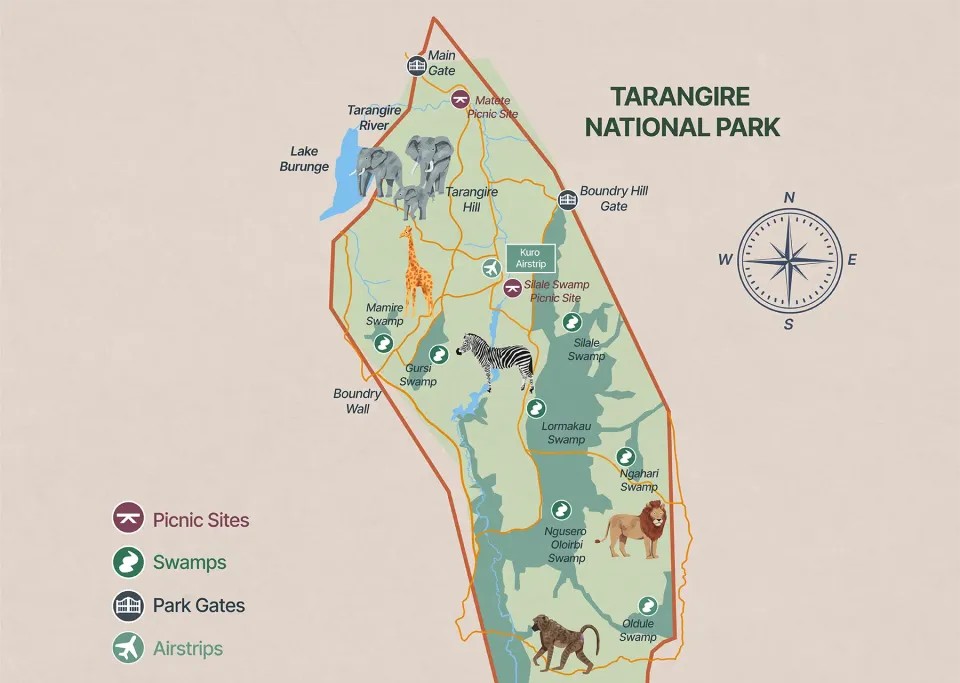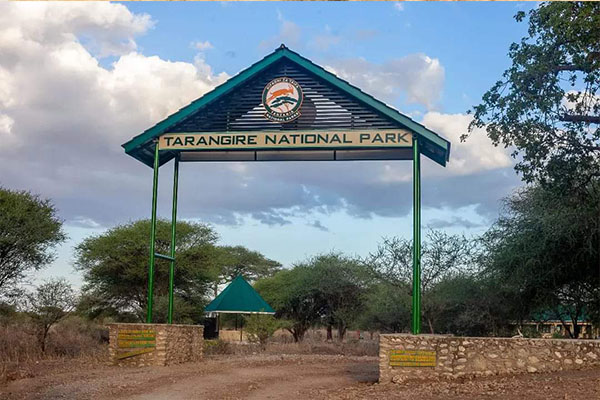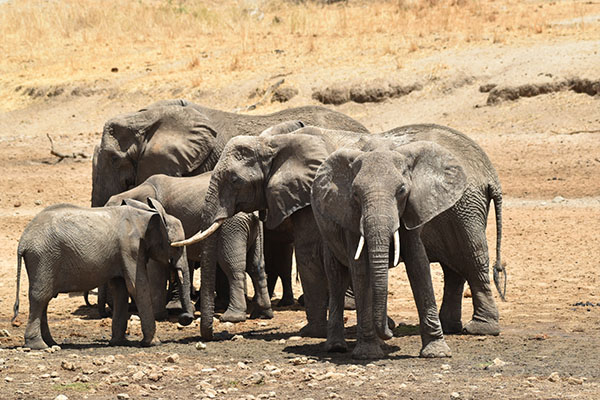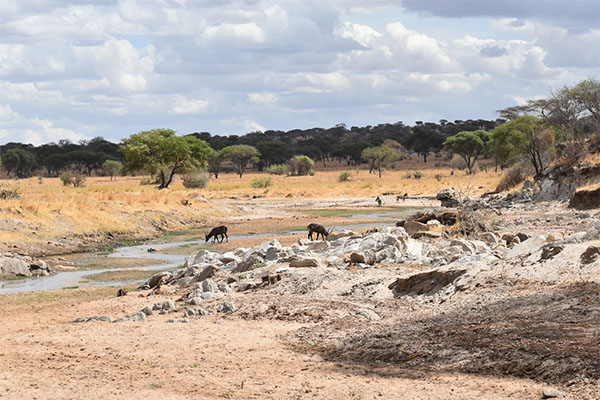Tarangire National Park
Tarangire National Park
The shy beauty near Arusha
Tarangire is one of the most beautiful national parks on Tanzania’s Northern Circuit and offers unforgettable safari experiences near Arusha. Here you can marvel at large herds of elephants, majestic baobab trees and the Tarangire River. Spend two nights here to explore the more remote corners of the park.
There is almost everything
A large herd of buffalo makes its way to the shallow waters of the Tarangire River, while elephants scratch their backs on the baobab trees and a lioness stretches out on an acacia tree and looks out over the swamps. Diverse and picturesque landscapes, a high density of wild animals and yet still one of the lesser-known national parks in Tanzania – that is Tarangire National Park.
Tarangire is conveniently located on the way to the more famous Serengeti National Park and the Ngorongoro Crater. But it’s also a popular park and excellent safari destination on its own – and much more than just a stopover on your trip!
The vegetation in the park is extremely diverse, from vast grassy areas, savannahs, baobab trees and dense acacia bushes to palm trees and swamps full of tall elephant grass in the south.
What’s to expect
Most visitors enter the park from the north and spend an afternoon exploring the area around the Tarangire River, which is the park’s lifeline and main source of drinking water. Elephants, buffalo, antelopes and zebras greet travelers and offer a classic safari experience.
Those staying more than just one night can explore Tarangire’s more remote southern part: the Silale Marsh is one of the main attractions here, covering 70 square kilometers. It is not only a popular spot for elephants, who enjoy the lush greenery, but also for big cats. If you’re lucky, you’ll see majestic lions skillfully climbing trees and resting in the shade, all the while keeping an eye on passing antelopes and zebras.
A few selected accommodations in the southern part of the park even offer walking safaris. An exciting activity that involves exploring the wildlife home on foot. Walking safaris are only permitted in a few selected national parks in Tanzania.
What animals can you see
An impressive variety of animals, both large and small, await you in Tarangire National Park. The park is home to numerous permanent residents, while others migrate back and forth depending on the season. The most commonly observed animals include elephants, giraffes, impalas, warthogs, zebras, wildebeests, dwarf mongooses and ostriches. However, you can also spot lions, leopards and occasionally even African wild dogs. The park is also home to 550 species of birds as well as greater and lesser kudu and oryx.
During the months of June to September, a small migration occurs in the park, with thousands of wildebeest and zebra moving to better grazing areas in the park. Elephants and other animals follow them and congregate along the Tarangire River, which is the only permanent water source in the park. Some estimates say that up to 2.000 elephants live in the park during these months, some of which come from as far away as Amboseli National Park in Kenya.
Predators
Cats are also very present in the park, and lions like to sunbathe on the river banks, while leopards occasionally take a nap in the baobab trees. There are also cheetahs here, although they are usually relatively difficult to spot because they hide from their unsuspecting prey.
African wild dogs have been spotted in the southern part of the park. As the number of these efficient hunters dwindles, a sighting is very special.
Birdslife
But it’s not just mammals that you can experience in Tarangire National Park, the park is also home to 550 different species of birds. The most commonly sighted birds include black-headed, red-billed toos, southern ground hornbills, forked rollers, ostriches, various species of raptors and waterfowl, to give just a little insight.
Vegetation and landscapes
The Tarangire National Park, with its landscape dotted with baobab trees, is one of the most scenic parks in Tanzania. The baobab trees tower high above the savannah. These centuries-old trees play an important role in the ecosystem, providing habitat for bees, birds and bats. In addition, they have juicy fruits and indirectly provide animals such as elephants with water, especially during the drier months.
Until the mid-1990s, one of these ancient trees served as a hiding place for illegal poachers. The inside of the huge tree offered them perfect protection from the patrolling park rangers. Once inside they were invisible. Here they dried and stored illegally caught meat from wildebeest, buffalo and zebra. Luckily, the rangers were finally able to put an end to their illegal activities. Today you can visit the poachers’ hideout and go into the baobab tree yourself.
Tarangire River
The Tarangire River has water all year round and is an important lifeline for many residents, especially during the dry season. The river flows into Lake Burunge in the northwest. In the southern part of the park there is an extensive swamp area that is not accessible during the rainy season but dries up completely in the dry season.
Best time to travel
Tarangire looks very different depending on the season. During the rainy season, the grass stands tall, the river babbles and the vegetation blooms in all its glory. The wildlife is spread throughout the park as there are enough water sources. Due to the dense vegetation, wildlife viewing is not always easy, but bird lovers can spot many migratory birds in the park. The peak of the rainy season is usually between March and May.
However, the best time to visit Tarangire National Park is undoubtedly the dry season from June to October and early November. Animal density is high as many animals migrate from surrounding areas to the area’s main water source, the Tarangire River. Due to the sparse vegetation, the animals can be easily spotted. Generally lower prices apply in the rainy season, while in the dry season it may be difficult to book accommodation at short notice.
Elephants drinking
The Tarangire River has water all year round, but during the dry season some parts of the river dry out. At this time you can observe something fascinating: elephants can smell water from many kilometers away. They use their trunk to dig a hole in what looks to us like a dry riverbed. The elephants suck water from the ground to quench their thirst. An additional advantage: Once the elephants have drunk enough, other animals gather and use these small wells as a water source.
Location
Tarangire National Park is part of the Northern Circuit, the main safari route in Tanzania. It is only about 120 km from Arusha, making it a popular stopover for day trips or the first stop on longer safaris. Most travelers enter the park through the main gate to the north; You can also arrive through the Sangaiwe or Boundary Hill gates. From Tarangire National Park you can continue your journey across Lake Manyara to the Ngorongoro Crater and further into the Serengeti.

Photos from Tarangire National Park









Video from Tarangire National Park
INQUIRE TARANGIRE NATIONAL PARK TOUR
Start planning your Tarangire National Park tour by filling the form below
